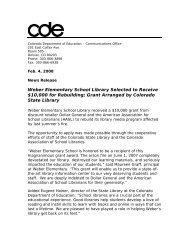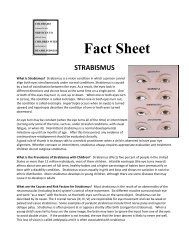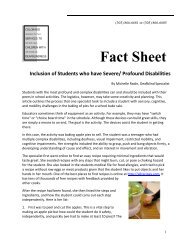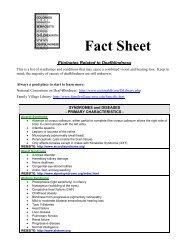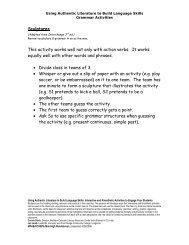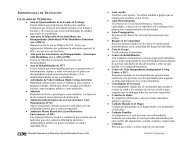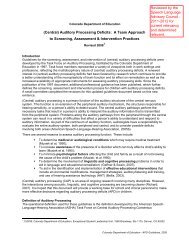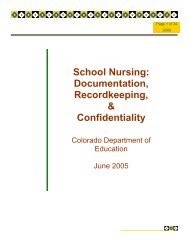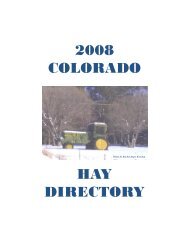ONLINE EDUCATION INTERIM REPORT - Colorado Department of ...
ONLINE EDUCATION INTERIM REPORT - Colorado Department of ...
ONLINE EDUCATION INTERIM REPORT - Colorado Department of ...
You also want an ePaper? Increase the reach of your titles
YUMPU automatically turns print PDFs into web optimized ePapers that Google loves.
20<br />
6. FUNDING<br />
Full-time online schools are funded differently<br />
than other schools in <strong>Colorado</strong>. Unlike all other<br />
schools, online schools receive the minimum PPR<br />
amount, equal to the total program amount that<br />
the lowest funded school district receives. For<br />
the 2006-07 school year, that amount is $5,865.<br />
This section will discuss the policy implications,<br />
incentives and disincentives resulting from this<br />
structure.<br />
Estimated Costs <strong>of</strong> Online Schools<br />
One consideration is how closely the funding<br />
level refl ects actual costs. Over the past years,<br />
several studies have attempted to estimate<br />
the real costs <strong>of</strong> online education, resulting in<br />
a wide range <strong>of</strong> fi gures. These studies have<br />
A 17-year-old North High School student, Andrew, was orphaned<br />
in August <strong>of</strong> 2005. He and his fi ve siblings continued to<br />
live alone in their “Section 8 home,” without adult supervision—<br />
the oldest was 20 and the youngest 12. Andrew began sleeping<br />
until noon every day and was subsequently kicked out <strong>of</strong> North<br />
High School, CLA, Emily Griffi th and La Academia Inner City Parish<br />
School. He also had some troubles with the Law. Andrew’s mentor,<br />
from Save Our Youth, was introduced to Hope Online in May <strong>of</strong><br />
2006 and decided to try online education as a last resort. Some<br />
incentives were put in place to get Andrew focused. The computer<br />
tested Andrew and, as you would expect, found numerous “holes”<br />
in his education. Andrew had to go back to 3rd grade and repeat<br />
four “teaching units” <strong>of</strong> arithmetic. He needed a lot <strong>of</strong> mentor-<br />
ing in the early going. He then worked hard to get through 4th,<br />
5th and 6th grades. Just before Thanksgiving, after watching a<br />
Broncos football game, Andrew told his mentor that “for the fi rst<br />
time he understood average yards per carry and pass completion<br />
percentage.”<br />
Andrew completed 7th grade before Christmas and 8th grade<br />
in January. He now is progressing quickly and needs much less<br />
mentoring or adult assistance. Andrew is rapidly fi lling in the holes<br />
in his High School education and will graduate in June with his age<br />
group. Recently Andrew took a practice test on Accu-Placer (a re-<br />
spected junior college placement exam), and he scored quite well.<br />
A few more educational holes to patch-up, using Hope Online, and<br />
then Andrew should be <strong>of</strong>f to college.<br />
acknowledged that online schools have different<br />
costs than physical schools, some factors leading<br />
to higher costs and others leading to lower<br />
costs. For example, online schools have higher<br />
technology, Internet and computer costs, as well<br />
as costs to cover CSAP centers where online<br />
students complete the standardized test. Relative<br />
to physical schools, online schools have lower<br />
costs in the areas <strong>of</strong> facilities, transportation,<br />
materials, teachers, and administration.<br />
Although such cost estimate studies have been<br />
conducted in states throughout the country,<br />
it is relevant to this report to address those<br />
covering <strong>Colorado</strong>. For this state, the studies<br />
have included a report to the governor’s 2002-<br />
03 online education committee, another survey<br />
conducted by the <strong>Colorado</strong> Cyberschool<br />
Association, and a recent study completed by<br />
the consulting fi rm <strong>of</strong> Augenblick, Palaich, and<br />
Associates (APA). The per pupil cost estimates<br />
<strong>of</strong> these studies range from about $5,700 to<br />
$12,000. The study from 2002-03 projected that<br />
in <strong>Colorado</strong> the average cost <strong>of</strong> providing fulltime<br />
online education ranged from about $6,000<br />
to $6,800 per student. The APA study based<br />
its estimates on different quality levels, ranging<br />
between $7,200-8,300 per pupil, depending on a<br />
range <strong>of</strong> quality and administrative variables. 1<br />
Regardless <strong>of</strong> what the actual or estimated<br />
costs <strong>of</strong> full-time online education, the reality<br />
in this state (and some others) is that the per<br />
pupil funding amounts for online education and<br />
physical school education are determined by<br />
the legislature based on available resources. In<br />
<strong>Colorado</strong>, this amount is also subject to state<br />
fi scal requirements and restrictions – notably<br />
Amendment 23, TABOR, the six percent annual<br />
spending limit, and the Gallagher Amendment.<br />
As with physical schools, online schools should<br />
spend their funds appropriately to best serve<br />
their students. The money does not follow<br />
a specifi c child. Just like school districts,<br />
economies <strong>of</strong> scale and additional funding<br />
provide for improved support and services




